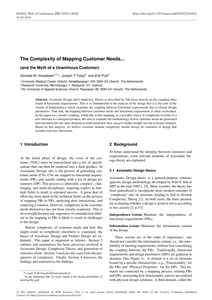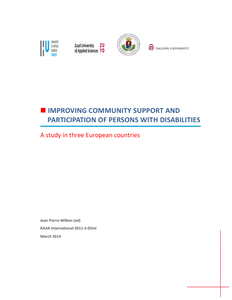During the past years a lot of research has been done on measuring and analyzing the stated and re-vealed preferences of house buyers, in order to develop so called new product market combinations for the housing market. It has become clear from these studies that the choice of a house buyer for a cer-tain type of dwelling is based on both quantitative and qualitative criteria, derived from the quantita-tive and qualitative attributes he observes and perceives when confronted with the choice for a dwell-ing. A dwelling as such, can be regarded as a complex ‘product’, consisting of a varied amount of quantitative and qualitative attributes. A dwelling not only offers a place to eat, sleep and live, but also a place of comfort and safety. For a growing group of house buyers their dwelling seems to be-come more and more even like ‘a statement of life style’, in the same way a dwelling was regarded as ‘a statement of richness’ in the earlier days. The focus of researchers is gradually moving towards the qualitative criteria that determine the choice behaviour of house buyers. Or, more specifically, towards the relationships between the preferences, perceptions, emotions and beliefs of the house buyer and the quantitative and qualitative criteria he has in mind. And, secondly, they want to understand how these aspects are related to the actual choice for a dwelling. An intriguing question is how these preferences, perceptions, emotions and beliefs (i.e. psychological factors) can be measured and analyzed in such a way that they can be described and communicated unambiguously to different parties that are involved in the housing market. The aim of this conceptual paper is to make a start with the exploration of the expected added value of Conjoint Analysis and Rule Developing Experiment as tools for measuring and analyzing the combi-nation of quantitative and qualitative criteria that direct the choice behaviour of house buyers. Conjoint Analysis, which has originally been developed for marketing applications, analyzes the joint subjective and psychological factors that influence the choice behavior of consumers. Applying Con-joint Analysis as a method of research, will not only add to the measurement and analysis of stated and revealed preferences of house buyers. It may be also of help to develop knowledge on unstated and even innovative preferences, which will eventually lead to innovative, yet unknown dwelling concepts and dwelling market combinations. These unknown combinations might be found by adding the method of Rule Developing Experiment.
DOCUMENT
Insider ethnographic analysis is used to analyze change processes in an engineering department. Distributed leadership theory is used as conceptual framework.
DOCUMENT
Project objectives Radicalisation research leads to ethical and legal questions and issues. These issues need to be addressed in way that helps the project progress in ethically and legally acceptable manner. Description of Work The legal analysis in SAFIRE addressed questions such as which behavior associated with radicalisation is criminal behaviour. The ethical issues were addressed throughout the project in close cooperation between the ethicists and the researchers using a method called ethical parallel research. Results A legal analysis was made about criminal law and radicalisation. During the project lively discussions were held in the research team about ethical issues. An ethical justification for interventions in radicalisation processes has been written. With regard to research ethics: An indirect informed consent procedure for interviews with (former) radicals has been designed. Practical guidelines to prevent obtaining information that could lead to indirect identification of respondents were developed.
DOCUMENT

A case study and method development research of online simulation gaming to enhance youth care knowlegde exchange. Youth care professionals affirm that the application used has enough relevance as an additional tool for knowledge construction about complex cases. They state that the usability of the application is suitable, however some remarks are given to adapt the virtual environment to the special needs of youth care knowledge exchange. The method of online simulation gaming appears to be useful to improve network competences and to explore the hidden professional capacities of the participant as to the construction of situational cognition, discourse participation and the accountability of intervention choices.
DOCUMENT

When it comes to hard to solve problems, the significance of situational knowledge construction and network coordination must not be underrated. Professional deliberation is directed toward understanding, acting and analysis. We need smart and flexible ways to direct systems information from practice to network reflection, and to guide results from network consultation to practice. This article presents a case study proposal, as follow-up to a recent dissertation about online simulation gaming for youth care network exchange (Van Haaster, 2014).
DOCUMENT

Wat is de rol van prijs in duurzaam consumentengedrag? ‘Omdat het te duur is’ is een veelgehoord argument wanneer mensen wordt gevraagd waarom ze geen duurzame producten kopen. Maar is dat werkelijk zo, of is dit een makkelijk alibi van mensen om niet hun gedrag te hoeven veranderen? We zijn over het algemeen niet bepaald armlastig in de westerse wereld, dus is het werkelijk een gebrek aan geld, of is er een andere oorzaak van dit gedrag? Om daar een uitspraak over te kunnen doen, hebben we de literatuur onderzocht op de relatie tussen prijs en duurzaamheid. Overall conclusie: een bepaalde groep mensen geeft in onderzoeken aan best bereid te zijn om meer te betalen voor duurzamere oplossingen, tot wel 29%. Maar sociale wenselijkheid speelt daarbij waarschijnlijk een grote rol. Want gezien het nog geringe marktaandeel van duurzame producten is de realiteit weerbarstiger. De meerderheid van de mensen is kennelijk nog niet zodanig overtuigd van de meerwaarde dat ze er ook extra geld voor over hebben. Dit document is opgedeeld in twee secties: 1. sectie 1 beschrijft een analytische beschouwing van de literatuur. Dit onderzoek schetst de ontwikkeling van de artikelen die tot dusverre gepubliceerd zijn over bereidheid van consumenten om een meerprijs te betalen voor duurzame producten; 2. sectie 2 beschrijft een inhoudelijke beschouwing van een selectie van de literatuur: specifiek artikelen die (experimenteel) onderzoek beschrijven naar de willingness to pay voor duurzame producten en diensten.
DOCUMENT

Aim and method: To examine in obese people the potential effectiveness of a six-week, two times weekly aquajogging program on body composition, fitness, health-related quality of life and exercise beliefs. Fifteen otherwise healthy obese persons participated in a pilot study. Results: Total fat mass and waist circumference decreased 1.4 kg (p = .03) and 3.1 cm (p = .005) respectively. The distance in the Six-Minute Walk Test increased 41 meters (p = .001). Three scales of the Impact of Weight on Quality of Life-Lite questionnaire improved: physical function (p = .008), self-esteem (p = .004), and public distress (p = .04). Increased perceived exercise benefits (p = .02) and decreased embarrassment (p = .03) were observed. Conclusions: Aquajogging was associated with reduced body fat and waist circumference, and improved aerobic fitness and quality of life. These findings suggest the usefulness of conducting a randomized controlled trial with long-term outcome assessments.
DOCUMENT

Background: Structured psychotherapy is recommended as the preferred treatment of personality disorders. A substantial group of patients, however, has no access to these therapies or does not benefit. For those patients who have no (longer) access to psychotherapy a Collaborative Care Program (CCP) is developed. Collaborative Care originated in somatic health care to increase shared decision making and to enhance self management skills of chronic patients. Nurses have a prominent position in CCP’s as they are responsible for optimal continuity and coordination of care. The aim of the CCP is to improve quality of life and self management skills, and reduce destructive behaviour and other manifestations of the personality disorder. Methods/design: Quantitative and qualitative data are combined in a comparative multiple case study. This makes it possible to test the feasibility of the CCP, and also provides insight into the preliminary outcomes of CCP. Two treatment conditions will be compared, one in which the CCP is provided, the other in which Care as Usual is offered. In both conditions 16 patients will be included. The perspectives of patients, their informal carers and nurses are integrated in this study. Data (questionnaires, documents, and interviews) will be collected among these three groups of participants. The process of treatment and care within both research conditions is described with qualitative research methods. Additional quantitative data provide insight in the preliminary results of the CCP compared to CAU. With a stepped analysis plan the ‘black box’ of the application of the program will be revealed in order to understand which characteristics and influencing factors are indicative for positive or negative outcomes. Discussion: The present study is, as to the best of our knowledge, the first to examine Collaborative Care for patients with severe personality disorders receiving outpatient mental health care. With the chosen design we want to examine how and which elements of the CC Program could contribute to a better quality of life for the patients.
MULTIFILE

From the article: "Axiomatic Design and Complexity Theory as described by Suh focus heavily on the coupling often found in functional requirements. This is so fundamental to the analysis of the design that it is the core of the Axiom of Independence which examines the coupling between functional requirements due to chosen design parameters. That said, the mapping between customer needs and functional requirements is often overlooked. In this paper we consider coupling, found due to this mapping, as a possible source of complexity in terms of a user interface to a designed product. We also re-examine the methodology of how customer needs are generated and translated into the other domains to understand how they can give further insight into the customer mindset. Based on this analysis, we believe customer domain complexity should always be examined in design that includes end-user interaction."
MULTIFILE

This project builds upon a collaboration which has been established since 15 years in the field of social work between teachers and lecturers of Zuyd University, HU University and Elte University. Another network joining this project was CARe Europe, an NGO aimed at improving community care throughout Europe. Before the start of the project already HU University, Tallinn Mental Health Centre and Kwintes were participating in this network. In the course of several international meetings (e.g. CARe Europe conference in Prague in 2005, ENSACT conferences in Dubrovnik in 2009, and Brussels in April 2011, ESN conference in Brussels in March 2011), and many local meetings, it became clear that professionals in the social sector have difficulties to change current practices. There is a great need to develop new methods, which professionals can use to create community care.
DOCUMENT
